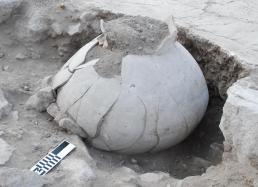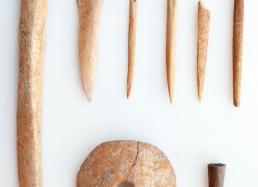2011: Tools & Trade
During the first two seasons (2009-10) at the Mitla Fortress, Dr. Feinman and his team explored adjacent terraces (56-57) that contained the residential complex of seemingly related individuals. Both the fine stonework and the household burial cist of a man missing his femur—presumably used by his descendents as symbol of rank during rituals—marked the complex as belonging to an extended family who had achieved a surprising level of status for commoners.
The number and type of tools, as well as the debris littering the two households in the complex, indicate that stoneworking, fiber production, and turkey raising were important occupations for the people who lived here for generations. But would these same findings hold true at other commoner houses across the site? By exploring a wider sample of homes along the base of the Mitla Fortress, Dr. Feinman hoped to discover whether most residents made their living in similar ways, and how they interacted with one another to produce their wares.
An Economic Focus on Fiber
Excavations during 2011 at Terrace 276 uncovered a shift in the focus of manufacturing cloth for commoners living in this lower-level complex. An abundance of perforating tools and a large olla (water jar) built into the activity area tell us that the family was involved in the early stages of processing agave into ixtle (fiber)—residents even devoted a large garden patio to growing these plants! In contrast, homes further upslope had much smaller garden spaces, but utilized more spindle whorls and other tools typically employed to spin ixtle into yarn and weave it into cloth.
This same status-driven pattern can be seen at El Palmillo, a site excavated by Dr. Feinman in 1999-2008. Here as at the Mitla Fortress, households in different sectors of the site appear to have formed an interdependent network specializing in various phases of cloth production. It is also likely that residents at both sites in this dry part of the valley produced surplus fiber and cloth to exchange for maize grown by neighbors living in wetter areas.
Reliance on Exchange and Social Networks
Graves and offerings found within the residential complex on Terrace 276 also tell a story of status and trade over time. Whereas residents living further upslope buried their relatives with obsidian points, fancy urns, and turkey eggs, downhill dwellers filled their tombs with offerings of chert tools, simple pots, and turtles. Interstingly, no matter their community standing, all housholds possessed goods clearly not produced at home, since no tools or manufacturing remnants were found nearby, and many of these goods appear to have been mass produced for exchange in the marketplace.
The pottery and stonework styles found at the terrace also reveal that the descendants of an extended family inhabited this terrace for five to seven centuries—and at least two hundred years past the fall of Monte Albán, and even the abandonment of El Palmillo. These findings help support the idea that the Zapotec economy was not entirely managed or controlled by the state, but was grounded in widespread household production and interdependence. Clearly, the Mitla Fortress was for most of its history more than a military outpost; it was a community that supported men, women, and their children for generations.
To learn more about Zapotec economy and the ways in which it differed from other state-controlled Mesoamerican economies, check out these additional articles by Dr. Feinman, Linda Nicholas, and their colleagues: A Multiscalar Perspective on Market Exchange in the Classic-Period Valley of Oaxaca, Preindustrial Markets and Marketing: Archaeological Perspectives, and The Late Prehispanic Economy of the Valley of Oaxaca, Mexico.




